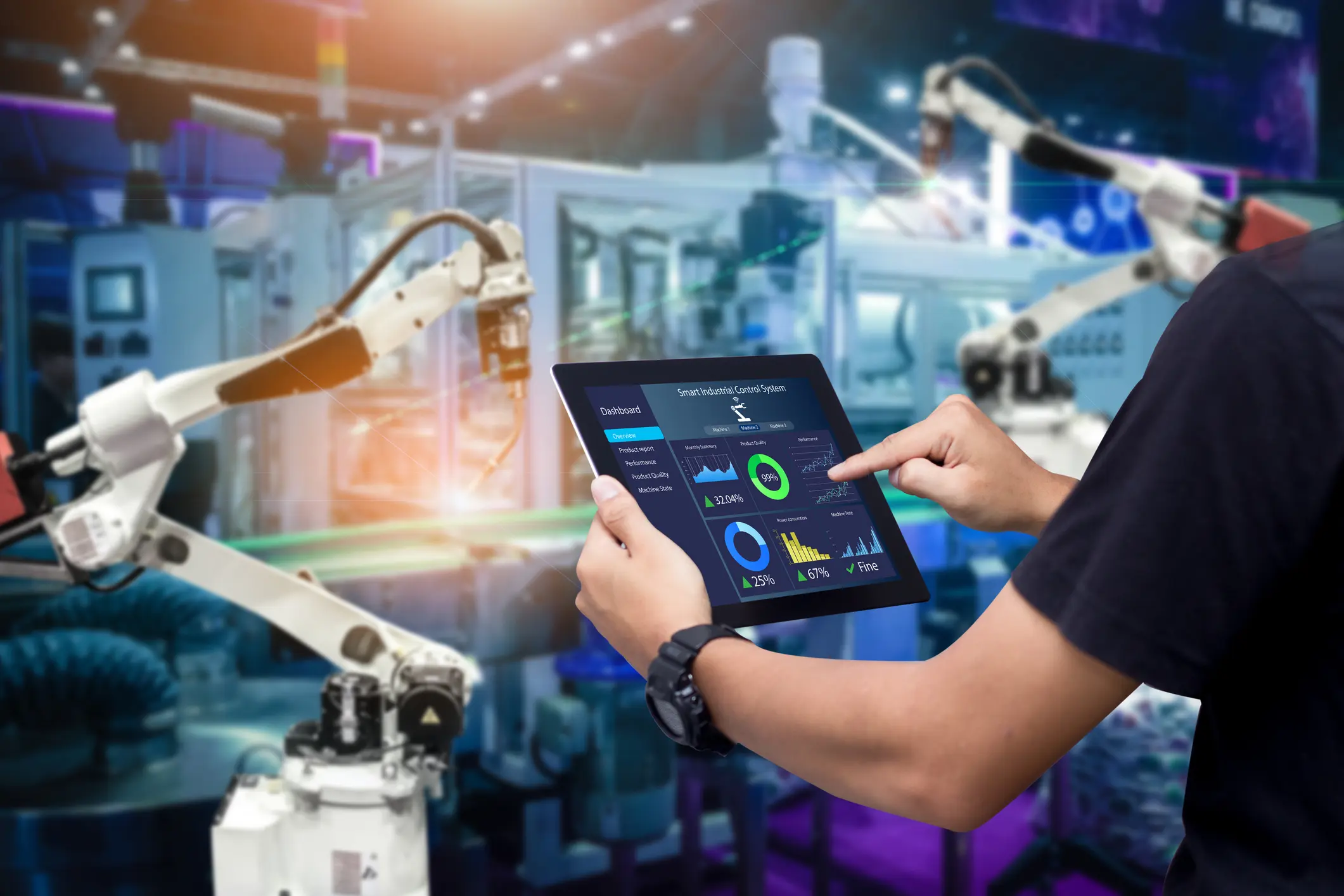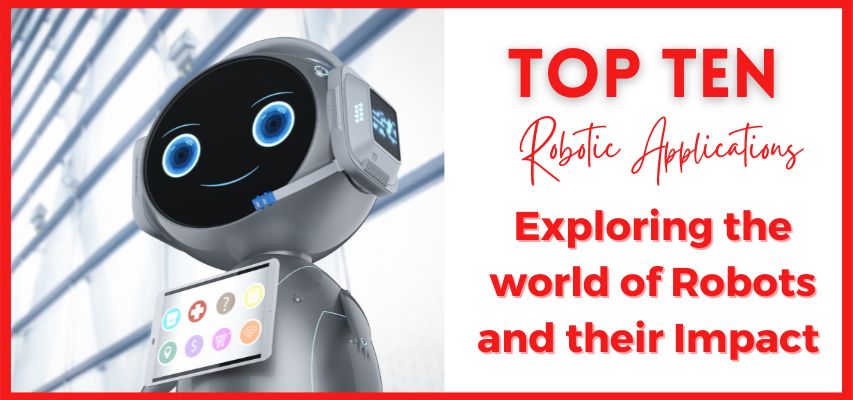In recent years, robots have transitioned from being mere science fiction fantasies to becoming integral parts of various industries and our daily lives. Robotic applications refer to the diverse ways in which robots are utilized to perform tasks, improve efficiency, and enhance human experiences. From manufacturing to healthcare, from exploration to entertainment, robots have proven their worth across different domains. In this blog, we will explore the top 10 robotic applications, understanding what they are, how they work, and their significance in today’s world.
Also, read: Top 10 Must-Have Cybersecurity Tools for Businesses
What are robotic applications?
Robotic applications are rapidly transforming our world, automating tasks across industries from manufacturing to healthcare. Industrial robots tirelessly perform repetitive tasks on factory floors, while surgical robots assist doctors in complex procedures. Logistics robots navigate warehouses, efficiently fulfilling orders, and agricultural robots plant seeds, harvest crops, and even monitor crop health with drones. Search and rescue robots enter hazardous zones to locate survivors, while military robots are used for bomb disposal and reconnaissance. Even our homes are seeing robotic helpers with floor cleaners and lawnmowers. Beyond our planet, exploration robots venture into space, and customer service chatbots answer questions and solve problems 24/7. These are just a few examples, and as robotics technology advances, we can expect even more innovative applications to emerge, forever changing the way we live and work.
Also, read: Top 10 Ethical Considerations of Artificial Intelligence in 2024
Benefits of robotic applications
There are many benefits to using robotic applications. Some of the key benefits include:
- Increased Productivity and Efficiency: Robots excel at repetitive tasks, working tirelessly to manufacture products faster and with greater consistency than humans. This translates to increased output and efficiency in industries like manufacturing and logistics.
- Enhanced Worker Safety: Robots can take on dangerous jobs like welding and handling heavy materials, reducing the risk of workplace injuries for human workers.
- Improved Product Quality: Precise movements and programmed instructions ensure consistent quality in robotic manufacturing, minimizing errors and defects.
- Reduced Costs: While there’s an initial investment, robots can save businesses money in the long run by lowering labor costs, reducing material waste, and improving overall production efficiency.
- Exploration and Intervention in Hazardous Environments: Robots can explore dangerous locations like collapsed buildings or radioactive zones, performing tasks or gathering data that would be too risky for humans.
- New Opportunities in Various Fields: Robotics is revolutionizing fields like healthcare with surgical robots that offer minimally invasive procedures and faster recovery times.
- 24/7 Assistance: Customer service chatbots powered by AI can answer questions and address concerns around the clock, providing consistent support to customers.
Also, read: Top 10 Emerging Medical Technologies Transforming Healthcare
Challenges of robotic applications
There are also some challenges associated with using robotic applications. Some of the key challenges include:
- High Costs: The initial investment in acquiring, installing, and programming robots can be significant, posing a hurdle for smaller businesses or organizations.
- Job displacement: As robots take over repetitive tasks, concerns arise about job displacement and the impact on the workforce. Reskilling and retraining initiatives may be necessary to address this challenge.
- Technical Complexity: Programming and maintaining complex robots requires skilled professionals, and there might be a shortage of such personnel in certain areas.
- Safety Concerns: While robots can enhance worker safety, proper safety protocols and precautions are crucial to avoid accidents involving human-robot interaction.
- Ethical Considerations: The use of robots in tasks like warfare or elder care raises ethical concerns that need careful discussion and regulations.
- Limited Decision-Making: Robots are currently limited in their ability to make complex decisions or adapt to unforeseen situations. Advancements in artificial intelligence are needed to address this limitation.
- Over-reliance on Automation: An over-dependence on automation could lead to a lack of innovation and problem-solving skills in the human workforce.
Also, read: Top 10 Must-Know Tech Skills for the Future Job Market
The Future is Now: Top 10 Mind-Blowing Robot Applications
Robots are rapidly transforming our world, taking on tasks that were once thought to be solely the domain of humans. From the manufacturing floor to the operating room, robots are making a significant impact on various industries. Here’s a glimpse into ten of the most prominent applications of robotics today:

1. Industrial Automation
One of the most prominent robotic applications is industrial automation, where robots are employed to automate manufacturing processes. These robots can efficiently perform repetitive tasks with precision, speed, and consistency. They work alongside human workers or autonomously, depending on the complexity of the task. Industrial robots have revolutionized industries such as automotive, electronics, and food production, leading to increased productivity and reduced human error.
2. Surgical Robotics
Surgical robotics has transformed the field of medicine, enabling surgeons to perform complex procedures with unparalleled precision and minimal invasiveness. Robotic surgical systems incorporate advanced imaging, robotic arms, and precise instruments, providing surgeons with enhanced dexterity and control during surgeries. This technology has led to shorter recovery times, reduced pain, and improved patient outcomes.
Also, read: Top 10 Real-World Benefits of R-IOT for Smart Cities
3. Autonomous Vehicles
Autonomous vehicles, also known as self-driving cars, are a groundbreaking robotic application in the transportation industry. These vehicles use sensors, cameras, and AI algorithms to navigate roads and reach destinations without human intervention. Autonomous vehicles have the potential to enhance road safety, reduce traffic congestion, and revolutionize public transportation and logistics.
4. Search and Rescue Robotics
Search and rescue robots play a crucial role in disaster response situations, where human intervention might be risky or challenging. These robots are equipped with sensors and cameras to locate survivors, assess dangerous environments, and deliver essential supplies. Their ability to access tight spaces and remote locations makes them invaluable during natural disasters and emergency scenarios.
Also, read: Top 10 Emerging Trends in the Internet of Things (IoT) and its Impact on Daily Life
5. Agricultural Robotics
Agricultural robots, also known as robots, are transforming the farming industry by automating tasks such as planting, harvesting, and monitoring crops. These robots can analyze soil conditions, apply fertilizers precisely, and use data-driven insights to optimize crop yields. By enhancing efficiency and reducing the need for manual labor, agricultural robots contribute to sustainable and eco-friendly farming practices.
6. Personal Assistance Robots
Personal assistance robots are designed to support individuals with daily tasks, especially older people or those with disabilities. These robots can provide companionship, remind users to take medications, assist with mobility, and perform simple household chores. With advancements in AI and natural language processing, personal assistance robots are becoming more adept at understanding and responding to human needs.
Also, read: Top 10 Advances in Bioprinting and its Ethical Considerations
7. Entertainment and Gaming Robots
Entertainment and gaming robots are designed to engage and entertain users. From interactive robotic toys to robotic pets and humanoid robots, this category includes a wide range of robots that captivate audiences of all ages. These robots amuse and serve as educational tools, promoting learning through play.
8. Space Exploration Robotics
In the field of space exploration, robots are indispensable tools for gathering data and conducting experiments in environments that are hostile to human beings. Space rovers like NASA’s Mars rovers have been instrumental in studying other planets and celestial bodies, providing valuable insights into our universe.
Also, read: Top 10 Must-Have Gadgets and Tech Gear for 2024
9. Environmental Monitoring Robots
Environmental monitoring robots play a crucial role in gathering data about the environment and wildlife. These robots can survey ecosystems, monitor pollution levels, track wildlife movements, and collect valuable data for conservation efforts—their contributions aid in understanding climate change, biodiversity, and ecological health.
10. Educational Robotics
Educational robotics involves using robots to teach and engage students in STEM (Science, Technology, Engineering, and Mathematics) subjects. Robotics kits and programming platforms enable students to learn coding, problem-solving, and engineering principles through hands-on experiences. Educational robotics fosters creativity and critical thinking, preparing students for future careers in technology and innovation.
These are just a few of the many robotic applications that are currently in use or being developed. As robotics technology continues to advance, we can expect to see even more innovative and widespread applications in the years to come.
Also, read: Top 10 Cybersecurity Threats to Businesses in 2024
FAQs: Robotic Applications Exploring The World Of Robots
Q: What is robotics?
Answer: Robotics is a branch of engineering and science that deals with the design, development, and application of robots. Robots are machines programmed to perform tasks autonomously or semi-autonomously, often mimicking human actions and intelligence.
Q: What are the main components of a robot?
Answer: A typical robot consists of several components, including sensors (to perceive the environment), actuators (to enable movement), a controller (to process information and make decisions), and an end-effector or tool (to interact with objects).
Also, read: Top 10 Emerging Technologies Shaping the Future of Work in 2024
Q: What is the difference between robotics and artificial intelligence (AI)?
Answer: Robotics is the study of physical robots and their design and application, while AI focuses on creating intelligent systems that can perform tasks that typically require human intelligence. Robotics often incorporates AI to enable robots to learn from data and make informed decisions.
Q: What are the benefits of using robots in industrial automation?
Answer: Introducing robots in industrial automation offers several advantages, including increased production efficiency, reduced labor costs, improved product quality, enhanced workplace safety, and the ability to handle repetitive and hazardous tasks.
Also, read: Top 10 Search Engines In The World (2024)
Q: Can robots replace human workers in the future?
Answer: While robots are becoming more capable and versatile, complete replacement of human workers is unlikely in most industries. Instead, robots are expected to complement human labor, taking on repetitive and dangerous tasks while humans focus on more complex and creative aspects of work.
Q: What are the applications of AI in robotics?
Answer: Artificial Intelligence (AI) plays a pivotal role in enhancing robotics capabilities. Some applications of AI in robotics include:
- Autonomous Navigation: AI enables robots to navigate and interact with their surroundings without human intervention.
- Object Recognition: AI algorithms help robots identify and interpret objects and environments through computer vision.
- Decision Making: AI enables robots to make complex decisions based on data analysis and learning from past experiences.
- Natural Language Processing: AI-powered robots can understand and respond to human commands and conversations.
- Adaptive Learning: AI allows robots to adapt and improve their performance based on real-time feedback.
Also, read: Top 10 Sports Betting Apps in 2024
Q: What is the real-life application of robotics?
Answer: Robotics has numerous real-life applications that have significantly impacted various industries and daily living. Some notable real-life applications include:
- Robotic Prosthetics: Robotics is used to develop advanced prosthetic limbs, enhancing mobility and functionality for amputees.
- Amazon’s Warehouse Robots: Amazon’s fulfillment centers use robots to efficiently pick, pack, and transport packages, streamlining order fulfillment processes.
- Robotic Companion Pets: Robots like PARO, a therapeutic robotic seal, provide companionship and emotional support to older people individuals, and patients in care facilities.
- Mars Rovers: Robotic rovers like NASA’s Curiosity and Perseverance explore the Martian surface, conducting scientific experiments and sending valuable data back to Earth.
Conclusion
The world of robotics is rapidly evolving, and its applications are expanding across various industries and aspects of human life. From automating industrial processes to assisting in surgeries, from exploring space to entertaining and educating, robots have proven to be powerful tools capable of transforming the way we live and work. As technology continues to advance, we can expect even more groundbreaking robotic applications that will further enrich our lives and drive progress in countless fields. Embracing these innovations responsibly and ethically will undoubtedly shape a promising future empowered by the potential of robotics.
Also, read: Top 10 Wearable Tech Gadgets for a Smarter Lifestyle in 2024


































